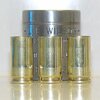Fishingted
Member
- Joined
- Nov 29, 2020
- Messages
- 328
Just Got one a few days ago. So far I like it a lot. Have used it to fix 40 S&W, 10MM, and 45 ACP. That didn't make it thru the gauge the first Time. Wish I had it mounted in a heavier Press but the Little RCBS Partner is working OK with it, So Far I am only using it on Loaded Bullets that I have already made and didn't go thru the gauge smoothly because of small base bulges. Get a good arm workout on some of them LOL. Just wondered if anyone else was using it and what your experiences might have been.






